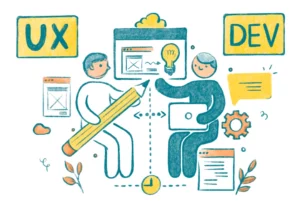Tips for better collaboration
Between UX designers and developers
Collaboration between UX designers and developers is essential for delivering products that offer both great user experiences and strong technical functionality. However, challenges often arise due to differences in communication styles, priorities, and understanding of each team’s role. UX designers may struggle to explain their design decisions, while developers may find it difficult to translate design concepts into functional code.
To bridge this gap, it’s important to establish clear communication, involve both teams early in the process, and foster a shared understanding of goals and terminology. This guide provides practical tips for enhancing collaboration between UX designers and developers, ensuring smoother workflows and better project outcomes.

UX maturity
As a UX designer, the first question you should ask yourself is how high the UX maturity is in your company. Organizations with low UX maturity tend to underestimate human-centered thinking and often skip key project phases (UX discovery, research, analysis). Many professionals in these organizations misunderstand the purpose of UX design and underestimate its value.
If there’s a fundamental lack of understanding regarding the purpose of UX design, you can improve communication with the UX team. Try some of these tips:
- UX language:
Use clear language and explain all the basic concepts and principles, such as accessibility, user research, and design thinking. Consider making a quick guide for newcomers. - UX value:
Explain the value of each UX phase, especially to those in decision-making roles. Be sure to include appropriate time frames for the current project. - Collaborate:
Involve other teams as early as possible in the UX process. The development team will gain a better understanding of the working process, the problem, and the possible solutions. This way, you can gather diverse perspectives on various topics, and you may also discover technical limitations that could change your decisions. - Use metrics:
Track some crucial metrics (user satisfaction, task success, engagement, error rate, loading time, etc.) that will back up your team’s decisions. UX is not just about creating pretty interfaces but usable products that solve problems. If you present designs and ideas that are based on real metrics, other teams will see the value of a good user experience. - Value other teams time:
This meeting could be an email, chat or document. Think about what information can be saved for others and what important points may be missed.
Realtime activities
Always consider what type of activity is appropriate for the moment — synchronous or asynchronous. Synchronous activities and real-time collaboration are essential when the content is complex and requires instant feedback or enhanced engagement.
- One-on-One meetings:
These can be quick check-ins between colleagues or longer meetings to resolve important issues and provide feedback. If it’s not a quick check-in, always prepare an agenda to save time for both parties. - Recurring meetings (standings):
Quick updates from everyone on the team to resolve bottlenecks and prioritize tasks. - Workshops:
Interactive sessions between teams can be helpful for problem-solving. Workshops encourage active participation from everyone involved and help make progress when teams are stuck on particular challenges. They are longer than regular meetings, so plan the activities ahead of time and prepare materials and tools. - Presentations and prototype demonstrations:
Use these activities to present new features and workflows. They are intended for a larger audience and don’t require active participation.
Asynchronous activities
Asynchronous activities are better when other teams have limited time or when participants have varying availability. These activities allow for flexibility and deeper reflection. Use them when the topic is not time-sensitive and when you can afford to give participants time to respond.
- Internal website or database of information:
Share UX resources on relevant topics, including news, industry trends, UX case studies, video demonstrations, slides, and tutorials. - Collaboration platforms:
Slack, Trello, Miro … you name it. Use them to start discussions, make reminders, perform surveys, promote and share knowledge, etc.
Speak one language
For efficient collaboration, both sides should use familiar technical terms. A shared understanding of terminology is crucial to ensure everyone is on the same page. Designers don’t need to know how to code but should understand basic concepts, technical terminology, and constraints. When discussing your goals use precise language that resonates with the developers domain.
Many designers struggle to communicate outside their team because they overestimate others’ understanding of basic design concepts and terminology. Conversely, developers may overestimate a designer’s technical understanding and use confusing terminology. Be patient and aim for mutual understanding.
Design handoff
This is a crucial stage of every project. Handoff meetings and documents bridge the gap between design and development. Use user flows and prototypes to explain the user experience, rather than relying solely on static screens and design mockups.
Feedback sessions
Once development begins, set checkpoints to review progress together. Ensure the final product aligns with the intended design by catching any misalignments early on. User experience is a shared responsibility, not just a project phase. Early feedback can prevent issues and save time in the long run.
Documentation
Maintain comprehensive documentation of design guidelines, styles, and patterns. Create a UI component library based on the product’s design system to ensure consistency. Record any changes to the original design to prevent misalignments. You can use software tools to ensure all documents are in one place and accessible to team members. Consider using tools like Notion, Dovetail, Google Drive, or Confluence.
In conclusion
Put time and effort into fostering close collaboration between UX and development teams. Don’t expect big changes overnight. Give everyone time to understand the importance of good communication and cooperation. Respect people’s time and avoid overcrowding their schedules with meetings.
Effective collaboration between UX designers and developers is crucial for creating products that are both functional and people-centered. By improving communication, involving teams early, and using clear language and metrics, designers can better convey the value of UX design.
In conclusion, be empathetic and aim for mutual understanding.